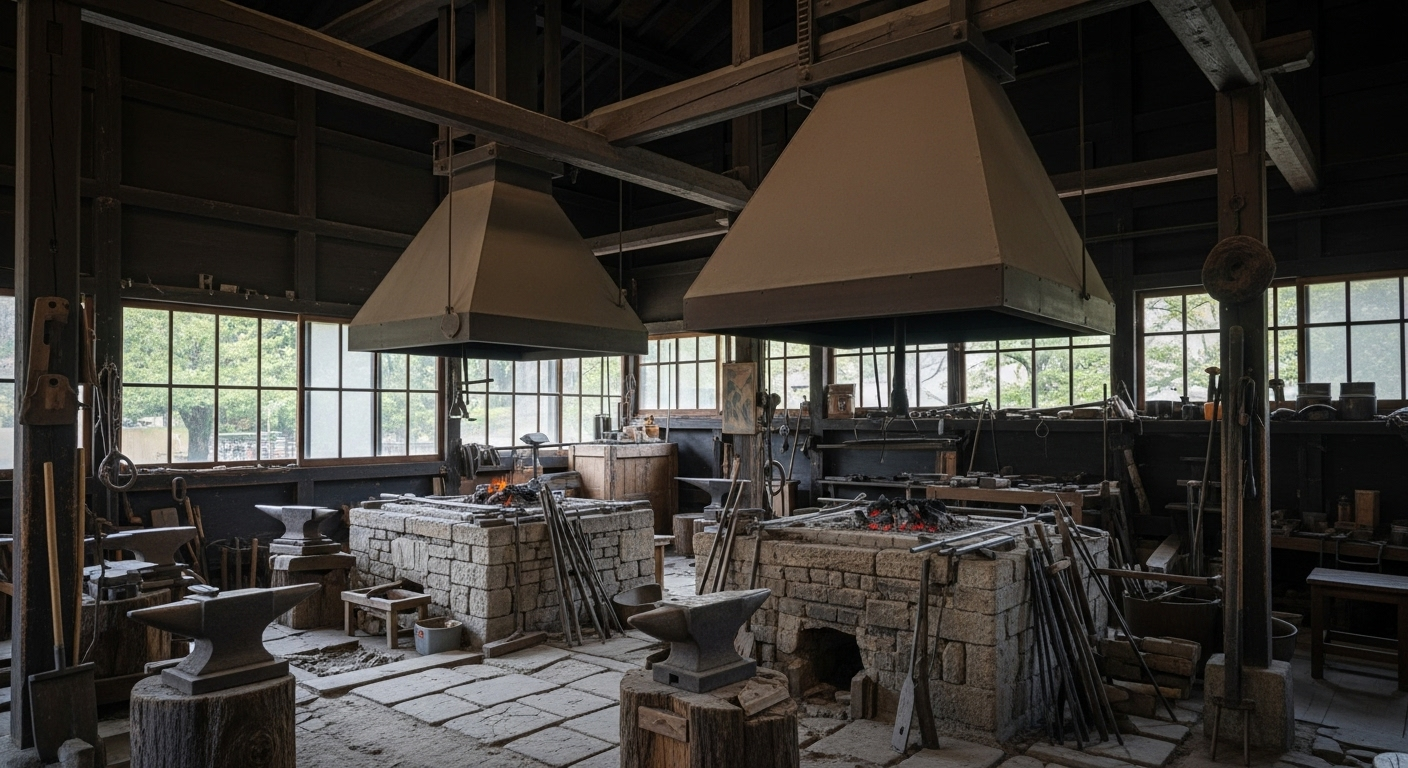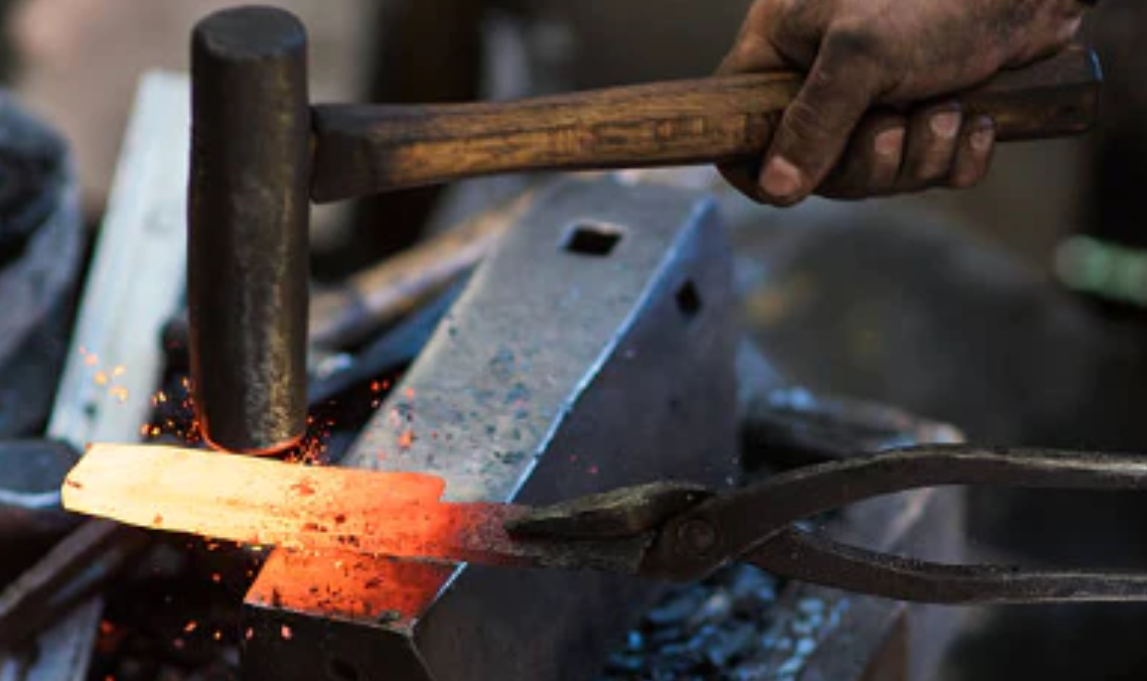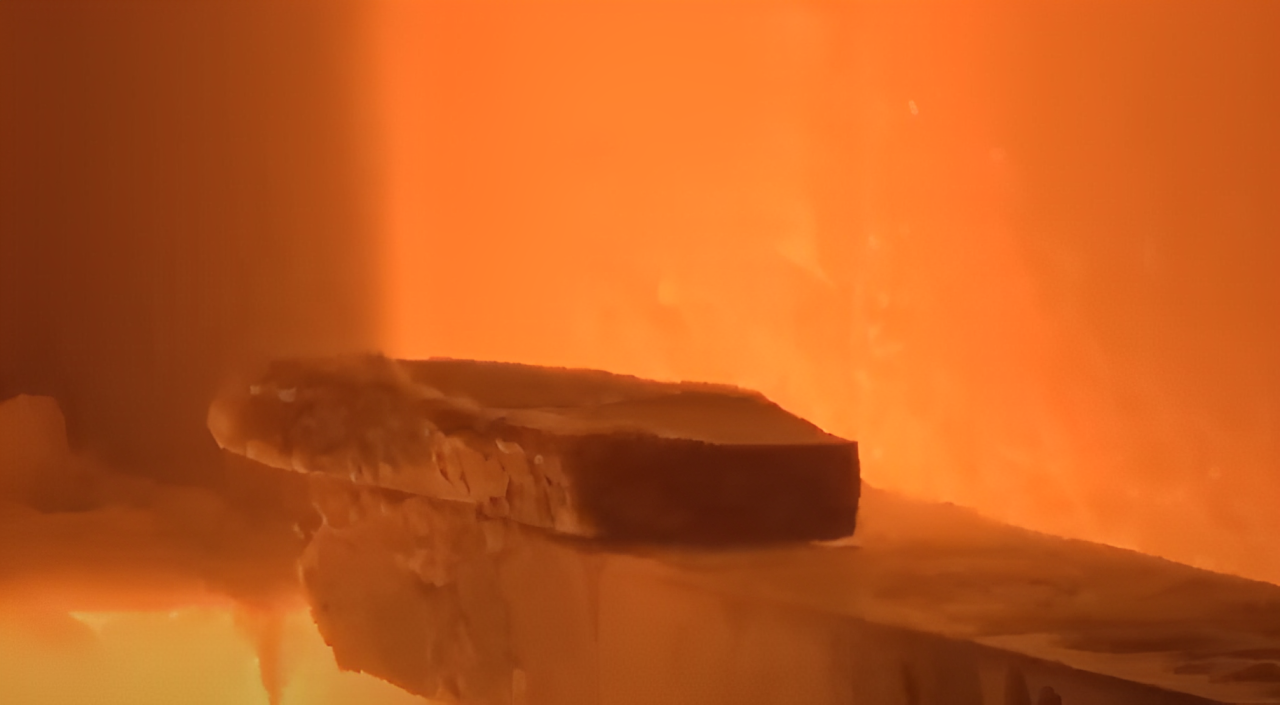
Type de couteau
-
Colonne
Chaque lame est façonnée par des siècles de tradition, affûtée avec précision et forgée dans le respect de ses ingrédients.
Mais pourquoi tant de monde ?
Derrière la variété se cache une philosophie qui transforme le simple acte de couper en une forme d’art. -

Yanagiba
Le KIREAJI Yanagiba est un couteau à sashimi traditionnel réputé pour sa lame longue et fine. Il permet un tranchage précis tout en préservant la texture délicate et la saveur naturelle du poisson cru, ce qui en fait un outil indispensable pour la préparation du sashimi.

Yanagiba (Sakimaru)
Le KIREAJI Sakimaru Yanagiba présente une élégante pointe incurvée, prisée dans la région du Kanto. Sa silhouette rappelant celle d'un katana lui confère une touche d'élégance, idéale pour les cuisines ouvertes où performance et présentation comptent.

Yanagiba (Kiritsuke)
Le KIREAJI Kiritsuke Yanagiba est un couteau hybride alliant la précision d'une lame à sashimi à la polyvalence d'un Kiritsuke. Sa lame large et épaisse excelle dans la découpe du sashimi et permet de réaliser facilement une grande variété de tâches.

Déba
Le KIREAJI Deba est conçu pour découper le poisson entier en toute confiance. Sa lame et son dos épais et robustes le rendent parfait pour couper les arêtes et les têtes. Il est également idéal pour la préparation de la viande, s'imposant comme un allié de confiance en cuisine.

Usuba
Le KIREAJI Usuba est un couteau à légumes à lame fine et plate, idéal pour l'épluchage et les découpes fines. Particulièrement adapté au katsuramuki (épluchage rotatif), c'est un couteau essentiel pour maîtriser les techniques traditionnelles japonaises de coupe des légumes.

Gyuto
Le KIREAJI Gyuto est une version japonaise du couteau de chef occidental. Polyvalent et bien équilibré, il permet de manipuler facilement viande, poisson et légumes, ce qui le rend populaire pour un large éventail de styles de cuisine.

Petit
Le KIREAJI Petty est un couteau utilitaire compact, idéal pour éplucher les fruits et les tailler avec précision. Petit mais tranchant, il est indispensable au quotidien pour une préparation précise en cuisine.

Garasaki
Le KIREAJI Garasaki est un couteau robuste conçu pour désosser le poisson et la volaille. Grâce à sa lame épaisse et durable, il résiste à un usage professionnel rigoureux et offre une résistance optimale là où elle est le plus nécessaire.

Autres types
Comprend le Santoku pour une utilisation polyvalente, le Takohiki pour des coupes de sashimi nettes et le Fuguhiki pour des tranches de fugu ultra-fines, chacun reflétant le dévouement du Japon à l'artisanat et à la saveur.
Type principal de couteau japonais
-
Vidéo fournie : chaîne YouTube Sabakeru (faisant partie du projet « L'océan et le Japon » de la Nippon Foundation)
-
Pourquoi existe-t-il autant de types de couteaux japonais ?
-
J'ai entendu un jour un chef étranger murmurer ceci avec émerveillement alors qu'il se tenait devant une exposition de couteaux japonais :
« On dirait plus un musée de lames qu’un magasin ! »Des noms comme Yanagiba , Deba et Usuba peuvent paraître étranges, et leurs formes variées peuvent laisser perplexes même les cuisiniers chevronnés. Mais cette variété apparemment impressionnante a une raison bien précise.
Le grand nombre de types de couteaux japonais existe parce que la cuisine japonaise est enracinée dans une culture qui accorde une valeur extraordinaire à l'acte de couper.
-
Une philosophie qui dit : « Couper d'abord, puis cuire »
Il existe une philosophie culinaire traditionnelle japonaise connue sous le nom de « Kasshu Hōjū » (割主烹従) — qui signifie littéralement « La coupe a la priorité ; la cuisson suit ».
En d'autres termes, la clé d'une cuisine savoureuse ne réside pas dans le feu ou l'assaisonnement, mais dans la façon dont elle est coupée. C'est particulièrement vrai pour les plats comme le sashimi ou les garnitures décoratives, où les ingrédients sont servis crus et non chauffés.
Dans ce contexte, le couteau n'est pas seulement un outil : c'est le principal moyen d'exprimer la saveur, la texture et la beauté des ingrédients. La coupe définit le plat, et la maîtrise de la lame définit le chef.
-

Prenons l'exemple du sashimi. Tranché avec un couteau Yanagiba d'un mouvement de traction fluide, il offre une texture incroyablement soyeuse qui fond presque sur la langue.
En revanche, l’utilisation d’un couteau émoussé ou inadapté écrase la chair, en évacuant l’humidité et en ternissant à la fois le goût et l’apparence.
Même un plat aussi simple que du radis daikon râpé, appelé tsuma , dépend du couteau. Coupés avec un couteau Usuba, les brins restent croquants, frais et presque translucides.
Il existe même un dicton japonais : « Une garniture de daikon joliment coupée est un plat en soi. »Dans la cuisine japonaise, couper n’est pas seulement une préparation : c’est une technique, une expression, un art.
-

Cuisine occidentale et japonaise : pourquoi la culture du couteau a divergé
Dans la cuisine occidentale, la saveur est souvent développée grâce à des techniques basées sur la chaleur, comme la cuisson au four ou la préparation de sauces. Par conséquent, la façon dont un aliment est coupé a moins d'impact direct sur le goût ou la texture.
Un couteau de chef polyvalent peut souvent traiter aussi bien les viandes, les poissons que les légumes.
Mais dans la cuisine japonaise, la découpe est indissociable de la saveur finale. C'est pourquoi des couteaux spécialisés ont été développés : un Deba pour découper le poisson entier, un Yanagiba pour trancher le sashimi et un Usuba pour le travail précis des légumes.
Le couteau doit être adapté à la tâche, car la coupe définit le résultat.
-
Chaque couteau japonais est conçu non seulement pour sa fonction, mais aussi pour une précision et un objectif de pointe .
・Yanagiba / Takobiki : Pour des tranches de sashimi longues et nettes qui préservent la structure du poisson
・Usuba : Pour les coupes de légumes délicates comme le katsuramuki (épluchage rotatif)
・Deba : Pour couper les arêtes de poisson sans écraser la chairCes couteaux ne sont pas seulement des outils, ce sont des œuvres d’art fonctionnelles.
Tout, de l'épaisseur de la lame et de l'angle de biseau à l'équilibre et à la conception du manche, est affiné pour s'adapter à un rôle culinaire spécifique.De plus, les chefs professionnels japonais aiguisent eux-mêmes leurs couteaux, les ajustant à leur prise en main et à leur style de coupe. Au fil du temps, le couteau devient le prolongement de la main du chef, reflet de sa discipline et de son savoir-faire.
-

En conclusion : la passion derrière la variété
Alors pourquoi existe-t-il autant de types de couteaux japonais ?
Parce que la cuisine japonaise repose sur la conviction que la façon dont on coupe un ingrédient détermine son goût.
Chaque couteau est né de la volonté de faire ressortir le meilleur de chaque ingrédient, à travers la coupe la plus appropriée et la plus respectueuse.Au Japon, un couteau n’est pas seulement un ustensile : c’est un outil d’expression, un symbole de respect de la nourriture et le reflet d’une philosophie culinaire vieille de plusieurs siècles.
La diversité des couteaux japonais témoigne d’une culture où « couper » n’est pas un moyen pour parvenir à une fin, mais le début de tout.
-
La véritable raison de tant de couteaux
Chaque lame existe pour faire ressortir le meilleur de son ingrédient , avec la coupe la plus respectueuse.
Un couteau japonais est plus qu’un ustensile : c’est un symbole de respect de la nourriture et le reflet d’un savoir-faire séculaire .
Pourquoi les couteaux japonais sont conçus de manière unique pour la précision
-

Les couteaux japonais sont conçus selon le principe que la coupe elle-même façonne la saveur , créant ainsi des outils spécialisés pour révéler les meilleures qualités de chaque ingrédient. Plutôt que de s'appuyer sur la chaleur pour développer le goût, la cuisine japonaise privilégie la précision, la pureté et la maîtrise de la lame , aboutissant à des couteaux adaptés à des tâches spécifiques, du sashimi aux légumes en passant par le poisson.
-


Why Japanese Knives Are Designed to Be Used Differently
Japanese knives are designed to do one thing exceptionally well.
This article explains why purpose-driven knife design—focused on hygiene, flavor preservation, safety, and technique—defines how Japanese knives are meant to be used, and how understanding this philosophy changes the way you cook.

Type de poignée
Les manches traditionnels allient légèreté, équilibre et confort, offrant au chef un contrôle précis et moins de fatigue. Tout comme la lame définit la performance, le manche complète l'harmonie entre la main et l'outil, ce qui en fait un choix essentiel lors du choix d'un couteau.
FAQ sur les types de couteaux japonais

01. Pourquoi les couteaux japonais sont-ils plus chers que les couteaux occidentaux ?
Les couteaux japonais sont bien plus que de simples ustensiles de cuisine : ce sont des œuvres de précision fabriquées à la main, avec une philosophie privilégiant la qualité à la rapidité. Leur prix reflète l'héritage, les matériaux et le savoir-faire. Chaque lame est forgée, traitée thermiquement et affûtée par des artisans qualifiés selon un processus long et complexe qui garantit un tranchant impeccable et une performance durable. Ils sont souvent fabriqués avec des aciers haut de gamme tels que le Shirogami (acier blanc) ou l'Aogami (acier bleu), réputés pour leur dureté et leur tenue du tranchant, mais qui nécessitent une grande expertise pour leur travail. Enfin, la diversité des couteaux adaptés à des tâches spécifiques ajoute à la fois complexité et valeur. Un couteau japonais n'est pas un produit de base ; c'est un investissement dans la tradition, l'art et la performance.
02. Pourquoi les chefs japonais utilisent-ils des couteaux différents pour différents ingrédients ?
Les couteaux japonais sont conçus dans le respect de chaque ingrédient. La précision est essentielle en cuisine japonaise, et utiliser le bon couteau garantit des coupes nettes et précises qui préservent saveur, texture et beauté visuelle. Un Deba coupe les arêtes de poisson sans abîmer la chair, un Yanagiba glisse sans effort pour des tranches de sashimi onctueuses, et un Usuba réalise des coupes fines comme du papier pour les légumes. Cette spécialisation améliore non seulement le plat, mais aussi le flux de travail, permettant aux chefs de préparer les plats plus efficacement tout en sublimant l'expérience culinaire.
03. Qu'est-ce qui rend les couteaux japonais exceptionnels en termes de qualité et de performance ?
Les couteaux japonais incarnent l'équilibre parfait entre élégance et efficacité. Leurs lames fines permettent des coupes d'une précision extrême, tandis que la dureté de l'acier assure durabilité et tranchant durable. Leurs tranchants sont si affûtés que trancher devient un jeu d'enfant. Ces qualités, affinées par des siècles de tradition, rendent les couteaux japonais à la fois hautement fonctionnels et extrêmement agréables à utiliser.
04. En quoi les couteaux japonais sont-ils différents des couteaux de style occidental ?
La différence la plus notable réside dans la géométrie de la lame et son mode d'utilisation. Les couteaux japonais sont souvent à simple biseau, affûtés d'un seul côté, ce qui permet une précision chirurgicale lors du tranchage et des travaux délicats. Ils sont généralement plus légers, avec un équilibre vers le manche, et comprennent des formes spécialisées telles que le Yanagiba, le Deba et l'Usuba. Les couteaux occidentaux, en revanche, sont à double biseau, ce qui les rend polyvalents et faciles à utiliser pour les préparations générales. Ils sont généralement plus lourds, avec un équilibre vers la lame, et comprennent des modèles courants comme le couteau de chef et le couteau d'office. En résumé, les couteaux japonais privilégient la technique et la précision, tandis que les couteaux occidentaux privilégient la polyvalence et la rapidité.
Pourquoi les couteaux japonais ont-ils souvent un seul tranchant ?
La raison pour laquelle les couteaux japonais ont souvent un seul tranchant est principalement due aux deux facteurs suivants :
- Adéquation aux méthodes de cuisson japonaises :
- Artisanat traditionnel japonais :
D'un autre côté, les couteaux occidentaux sont principalement à double biseau, conçus pour s'adapter aux tâches de « couper » et de « hacher » répandues dans la cuisine occidentale.
Ainsi, le biseau unique des couteaux japonais est une caractéristique issue de la culture culinaire japonaise et de l'histoire de ses techniques de fabrication.
Les couteaux diffèrent-ils selon les pays ?
Oui, les couteaux ont des caractéristiques différentes selon les pays ou les régions.
Couteaux japonais :
- Au Japon, les couteaux à simple biseau sont courants, adaptés aux tâches de tranchage et d'épluchage.
- Ils sont fabriqués selon une méthode traditionnelle connue sous le nom de « couverts forgés », qui permet d'obtenir des lames tranchantes et durables.
- Les types représentatifs incluent les couteaux Yanagiba et Deba.
- Ces dernières années, les couteaux japonais de haute qualité ont été très appréciés à l’étranger.
Couteaux occidentaux :
- Les couteaux occidentaux ont généralement un bord à double biseau, adapté aux tâches de coupe et de hachage.
- Dans des pays comme l’Allemagne, les couteaux estampés produits à la machine sont répandus.
- Les exemples typiques incluent les couteaux de chef et les couteaux d'office.
Ainsi, en raison des différences dans les méthodes de fabrication et les utilisations prévues, la forme et les caractéristiques des couteaux varient selon les pays et les régions.

Le moment où le fer et l'acier ne font plus qu'un. La précision de la température fait naître un savoir-faire artisanal
Pour forger du fer en acier, il faut avant tout maîtriser la température. Si elle est trop élevée, la structure s'affaiblit ; si elle est trop basse, elle ne se solidarise plus. Chaque jour, je procède avec la plus grande prudence, guidée par la chaleur.
L'origine de l'artisanat
-
L’esprit de l’artisan dans les couteaux japonais – La beauté et la maîtrise des lames traditionnelles
Les couteaux japonais ne sont pas de simples outils de cuisine ; ils sont l'épine dorsale de l'art culinaire, incarnant l' âme de la cuisine . Chaque type de couteau, qu'il s'agisse de l'usuba, du yanagiba ou du deba, a une fonction unique, et sa conception et ses caractéristiques sont le fruit d'une réflexion approfondie et d'un savoir-faire exceptionnel. En tant qu'artisans, nous mettons tout notre cœur dans chaque lame, en espérant que les chefs ressentiront cette passion lorsque le couteau reposera entre leurs mains.
-
Prenons par exemple le couteau usuba . Il est spécialement conçu pour travailler les légumes avec précision et grâce. Des tâches comme le katsuramuki (tranchage fin du radis daikon) mettent à l'épreuve l'habileté du chef, et le tranchant et l'équilibre de ce couteau font toute la différence. Cependant, la maîtrise exige du soin ; il est essentiel de maintenir le tranchant de la lame. Lorsqu'il est correctement entretenu, le couteau usuba rehausse la qualité de n'importe quel plat, transformant les ingrédients en art culinaire.
-
Le couteau Yanagiba , quant à lui, est conçu pour le sashimi, non pas pour « couper » mais pour « tirer » le poisson. Ce mouvement subtil mais délibéré met en valeur l'éclat et la texture naturels du poisson. La forme et le matériau du couteau Yanagiba reflètent notre engagement à permettre aux chefs de mettre en valeur leur savoir-faire. Les variantes régionales, telles que les styles Kanto et Kansai, mettent en valeur les diverses traditions culinaires du Japon et la fierté régionale.
-
Enfin, le couteau deba est un partenaire robuste pour fileter le poisson, avec sa lame épaisse et son poids solide permettant des coupes nettes à travers les arêtes tout en préservant la chair délicate. Lorsque nous fabriquons un couteau deba, nous imaginons le chef au travail, face à ses ingrédients avec concentration et détermination. Ce lien nous pousse à créer des outils qui soutiennent son art.
-
Les couteaux japonais sont le point de convergence du savoir-faire de l'artisan et de l'art du chef , permettant la création de plats extraordinaires. Leur précision et leur complexité témoignent de la profondeur de la cuisine japonaise et du lien entre un artisan et ses outils. Nous espérons que chaque tranche, chaque coupe et chaque tirage avec un couteau japonais résonneront avec ce dévouement partagé.
Comment sont fabriqués les couteaux japonais : la tradition Sakai
VIDÉO FOURNIE : ARTISANAT TRADITIONNEL JAPONAIS PLACE AOYAMA (YOUTUBE)
-
Lames forgées Sakai — Six siècles de savoir-faire inégalé
Appréciés par les chefs du monde entier et approuvés par 98 % des meilleurs professionnels de la cuisine japonaise , les couteaux Sakai sont plus que des outils : ils sont l'héritage vivant de plus de 600 ans de savoir-faire artisanal .
-
Chez KIREAJI, nous travaillons directement avec l' atelier de couteaux Shiroyama de Sakai, au Japon, garantissant que chaque lame est forgée à la main, finie à la perfection et expédiée directement de l'atelier aux cuisines du monde entier. Pas d'intermédiaire. Pas de production de masse. Uniquement des couteaux authentiques, fabriqués artisanalement , conçus pour sublimer votre cuisine tout au long de votre vie.




